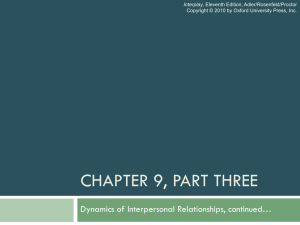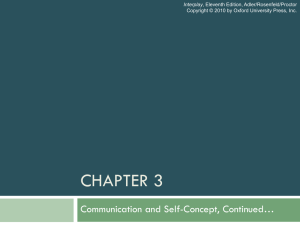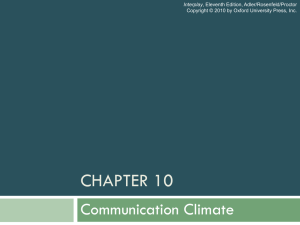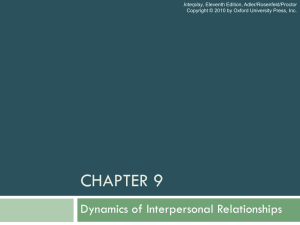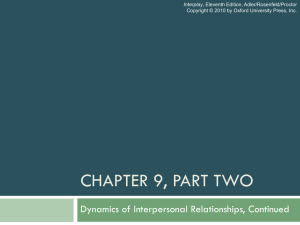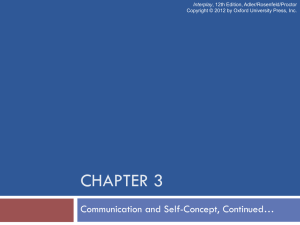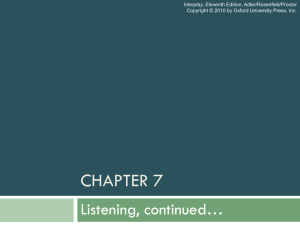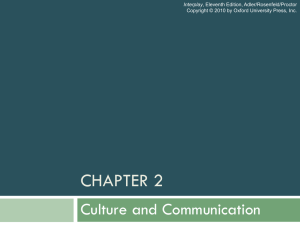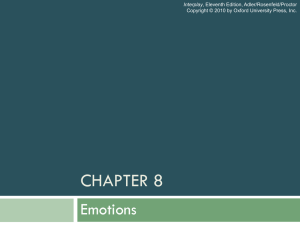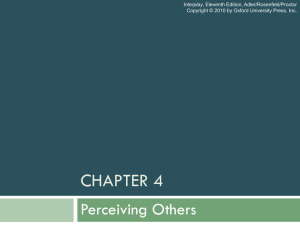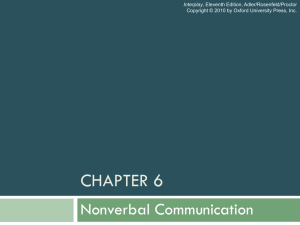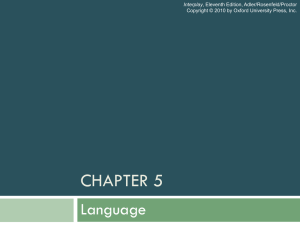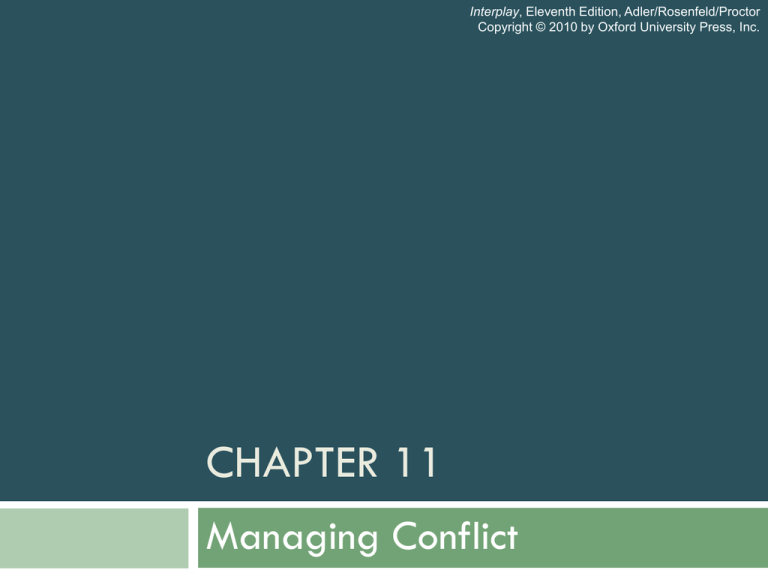
Interplay, Eleventh Edition, Adler/Rosenfeld/Proctor
Copyright © 2010 by Oxford University Press, Inc.
CHAPTER 11
Managing Conflict
Interplay
Section 1
WHAT IS CONFLICT?
Interplay, Eleventh Edition, Adler/Rosenfeld/Proctor
Copyright © 2010 by Oxford University Press, Inc.
Hocker and Wilmot definition…
“Conflict is an
expressed struggle
between at least two
interdependent parties
who perceive
incompatible goals,
scarce resources, and
interference from the
other party in achieving
their goals.”
Interplay, Eleventh Edition, Adler/Rosenfeld/Proctor
Copyright © 2010 by Oxford University Press, Inc.
Breaking down the definition…
Expressed struggle
Perceived incompatible goals
Not enough of something to go around.
Interdependent
When people perceive their goals to be mutually exclusive,
the conflict is real, albeit unnecessary.
Perceived scarce rewards
All people involved must know that some disagreement exists.
“We’re all in this together.”
Inevitability
Research: In both happy and unhappy relationships have
conflicts, but manage them in different ways.”
Interplay, Eleventh Edition, Adler/Rosenfeld/Proctor
Copyright © 2010 by Oxford University Press, Inc.
Interplay
Section 2
FUNCTIONAL AND
DYSFUNCTIONAL CONFLICTS
Interplay, Eleventh Edition, Adler/Rosenfeld/Proctor
Copyright © 2010 by Oxford University Press, Inc.
Functional and Dysfunctional Conflicts
Functional
Integration
Cooperation
Cooperation
Confirmation
Agreement
De-escalation
Focusing
Foresight
Dysfunctional
Polarization
Opposition
Disconfirmation
Disconfirmation
Coercion
Escalation
Drifting
Shortsightedness
Interplay, Eleventh Edition, Adler/Rosenfeld/Proctor
Copyright © 2010 by Oxford University Press, Inc.
Positive Versus Negative Results
Positive
Reward of successfully
facing a challenge.
Leaves partners feeling
better about themselves
and each other.
Learn more about each
other’s needs and how they
can be satisfied.
Relationship strengthens.
Safe outlet for feelings of
frustration and aggression.
Negative
No one gets what they
originally wanted
Today’s victor likely suffers
tomorrow at the hands of
the original loser
Dysfunctional conflicts
threaten the future of a
relationship
Dissolving a relationship in
the face of conflict is
hardly a satisfying pattern
Interplay, Eleventh Edition, Adler/Rosenfeld/Proctor
Copyright © 2010 by Oxford University Press, Inc.
Interplay
Section 3
CONFLICT STYLES
Interplay, Eleventh Edition, Adler/Rosenfeld/Proctor
Copyright © 2010 by Oxford University Press, Inc.
Avoidance (Lose-Lose)
Avoidance: When people
nonassertively ignore or stay
away from conflict.
Pessimistic attitude about conflict.
Avoiders put up with the status
quo.
Leads to unsatisfying
relationships.
Avoidance can help when:
risk of speaking up is too great
when the conflict isn’t worth the
effort
when the issue is temporary
Interplay, Eleventh Edition, Adler/Rosenfeld/Proctor
Copyright © 2010 by Oxford University Press, Inc.
Accommodation (Lose-Win)
Accommodation: When we
allow others to have their
own way rather than
asserting our point of view.
Accommodation could
enhance the relationship.
Important to examine the
role that culture plays.
Low-context cultures view
avoidance/accommodation
less positively.
Interplay, Eleventh Edition, Adler/Rosenfeld/Proctor
Copyright © 2010 by Oxford University Press, Inc.
Competition (Win-Lose)
Competition: Win-lose
approach to conflict that
involves high concern for
self and low concern for
others.
Ingrained in North
American culture.
Bid for control can breed
aggression.
Interplay, Eleventh Edition, Adler/Rosenfeld/Proctor
Copyright © 2010 by Oxford University Press, Inc.
Passive Aggression
Passive aggression: When
a communicator expresses
dissatisfaction in a
disguised manner.
“Crazymaking”: Tactics
deigned to punish another
person without direct
confrontation.
Guilt
Nonverbal; loud sigh,
pained expression
Humor, sarcasm
Interplay, Eleventh Edition, Adler/Rosenfeld/Proctor
Copyright © 2010 by Oxford University Press, Inc.
Direct Aggression
Direct aggression:
Character attacks
Competence attacks
Physical appearance attacks
Maledictions (wishing bad fortune)
Teasing
Ridicule
Threats
Searing
Nonverbal emblems (fist-shaking, waving
arms, etc.)
Severe impact on the target
Verbal aggression could have physical
impact
Can cause a destructive spiral
Interplay, Eleventh Edition, Adler/Rosenfeld/Proctor
Copyright © 2010 by Oxford University Press, Inc.
Compromise (Negotiated Lose-Lose)
Compromise: Gives both
people at least some of what
they want, although both
sacrifice part of their goals.
Approach does not deserve its
“positive” image
Costs involved can be great if
one person compromises values.
When compromises are
satisfying and successful, they
are categorized as
“collaboration.”
Interplay, Eleventh Edition, Adler/Rosenfeld/Proctor
Copyright © 2010 by Oxford University Press, Inc.
Collaboration (Win-Win)
Collaboration: Win-win
solutions to conflict that satisfy
all parties involved.
High degree of concern for
self and others; goal of
solving problems in “our way.”
Cooperative problem solving
is rare!
Win-win is not always possible
or appropriate; timeconsuming, some decisions
need to be made quickly.
Interplay, Eleventh Edition, Adler/Rosenfeld/Proctor
Copyright © 2010 by Oxford University Press, Inc.
Interplay
Section 4
WHICH STYLE TO USE?
Interplay, Eleventh Edition, Adler/Rosenfeld/Proctor
Copyright © 2010 by Oxford University Press, Inc.
Which Style to Use?
There is no single “best” way to respond to conflicts.
Consider
The situation
The other person
Your goals
Conflict is relational: Character is determined by the way the
people involved interact.
People develop a relational conflict style: A pattern of
managing disagreements that repeats itself over time.
Interplay, Eleventh Edition, Adler/Rosenfeld/Proctor
Copyright © 2010 by Oxford University Press, Inc.
Complimentary, Symmetrical, and
Parallel Styles
Complimentary conflict style:
Partners use different, but
mutually reinforcing behaviors.
Symmetrical conflict style:
People use the same tactics.
Parallel conflict style: Shifts
between complementary and
symmetrical patterns from one
issue to another.
Complementary “fight-flight”
style is common in many
unhappy marriages.
Interplay, Eleventh Edition, Adler/Rosenfeld/Proctor
Copyright © 2010 by Oxford University Press, Inc.
Complimentary, Symmetrical, and
Parallel Styles
Threats and insults lead to an
escalatory spiral.
When partners withdraw, a
complementary de-escalatory
spiral results.
Relationship is a shell of its former
self.
Symmetrical styles can be
beneficial when people
communicate assertively, listen to
other’s concerns, and working
together to resolve them.
Interplay, Eleventh Edition, Adler/Rosenfeld/Proctor
Copyright © 2010 by Oxford University Press, Inc.
Intimate and Aggressive Styles
Interaction between emotional
closeness and aggression.
Nonintimate-aggressive
Nonintimate-nonaggressive
Intimate-aggressive
Intimate-nonaggressive
Pattern helps identify types of
couples:
Separates
Intimates
Traditionals
Interplay, Eleventh Edition, Adler/Rosenfeld/Proctor
Copyright © 2010 by Oxford University Press, Inc.
Conflict Rituals
Conflict rituals
Unacknowledged, but very
real repeating patterns of
interlocking behavior.
Child interrupts parents
Parents tell child to wait
Child whines and cries
Parents listen rather than
ignore the fussing.
Rituals are a problem when
they are the only way
relational partners handle
conflicts.
Interplay, Eleventh Edition, Adler/Rosenfeld/Proctor
Copyright © 2010 by Oxford University Press, Inc.
Interplay
Section 5
VARIABLES IN CONFLICT STYLES
Interplay, Eleventh Edition, Adler/Rosenfeld/Proctor
Copyright © 2010 by Oxford University Press, Inc.
Gender
Research
Males use more competing
behaviors with same-sex
peers more avoiding
behaviors with opposite sex
peers
Women more concerned with
maintaining the relationship
during a conflict.
People perceive greater
differences than really
exist.
Interplay, Eleventh Edition, Adler/Rosenfeld/Proctor
Copyright © 2010 by Oxford University Press, Inc.
Culture
Assertive approach not the norm in the rest of the world.
Individualistic cultures, competing conflict style.
Collective cultures, accommodating, compromising, problemsolving styles.
“The first person to raise his voice loses the argument.”
More focus on face-saving.
Italians view heated debate as a “discussione.”
Approach to conflict: part of biological makeup, personality.
Self-concept: powerful than culture.
“Culture of relationship” shapes our behavior.
Interplay, Eleventh Edition, Adler/Rosenfeld/Proctor
Interplay, ©
Eleventh
Copyright
2010 byEdition,
Oxford Adler/Rosenfeld/Procto
University Press, Inc.
Interplay
Section 6
CONFLICT MANAGEMENT IN PRACTICE
Interplay, Eleventh Edition, Adler/Rosenfeld/Proctor
Copyright © 2010 by Oxford University Press, Inc.
Seven-Step Approach from
Weider-Hatfield/Raider
Define your needs
Share your needs with the other person
1.
2.
3.
4.
5.
6.
7.
Choose suitable time/place
Use “I” language
Listen to the other person’s needs
Generate possible solutions
Evaluate the possible solutions and choose the best
one
Implement the solution
Follow up on the solution
Interplay, Eleventh Edition, Adler/Rosenfeld/Proctor
Copyright © 2010 by Oxford University Press, Inc.
Interplay
END OF SECTION
Interplay, Eleventh Edition, Adler/Rosenfeld/Proctor
Copyright © 2010 by Oxford University Press, Inc.

